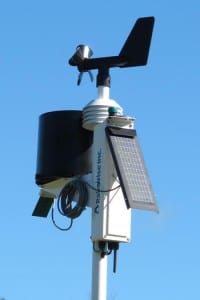 It hurts when codling moths riddle your apples, powdery mildew blasts your grapes, or anthracnose takes over your turf. But it’s really nettlesome when growers or groundskeepers mere miles away get off without a snag. Blame it on the weather: on a multitude of variables that we barely notice.
It hurts when codling moths riddle your apples, powdery mildew blasts your grapes, or anthracnose takes over your turf. But it’s really nettlesome when growers or groundskeepers mere miles away get off without a snag. Blame it on the weather: on a multitude of variables that we barely notice.
Sophisticated weather stations can pick up on those variables and even predict when and where pests will most likely erupt. “But the data the National Weather Service tracks for an entire region probably isn’t what happened on your farm or ballfield,” says Mary Concklin, a UConn Extension specialist in integrated pest management, or IPM.
That’s why Concklin is spearheading installations of 40 new RainWise AgroMET weather stations statewide. These small but powerful stations will stream realtime IPM pest forecasts to local farmers via the internet, thanks to NEWA — the Network for Environment and Weather Applications — with 250 small yet sophisticated weather stations in a network spanning Pennsylvania to Vermont. NEWA’s forecasts provide a heads-up on which pests are on the move and take whether they’re likely to cause harm.
After all, spraying for a pest that isn’t there doesn’t do much for a farmer’s bottom line, let alone the environment. Based at Cornell University in New York, NEWA’s IPM pest forecasts are free to the public.
Connecticut’s buy-in breaks new ground for NEWA. Sixteen of those 40 stations are county-based and will be largely used by turfgrass, grounds, and school IPM programs.
“These are new audiences for NEWA,” says Julie Carroll, a Cornell University fruit IPM specialist with the New York State IPM Program and a driving force behind NEWA’s growth. “Connecticut’s participation provides an exceptional opportunity to develop models for these industries.”
Visit NEWA and learn more at newa.cornell.edu.